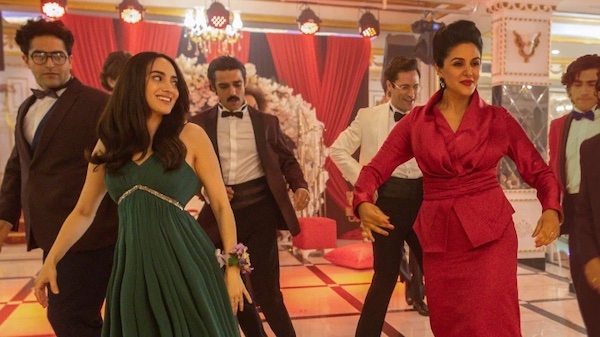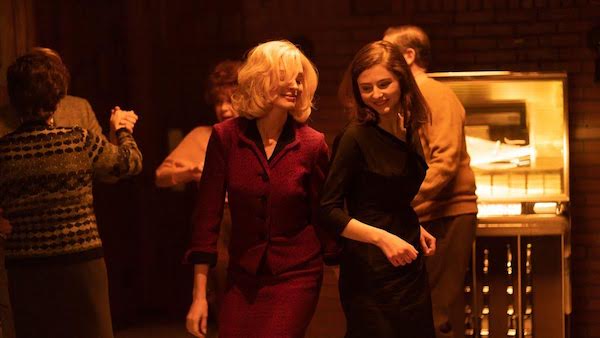Sundance Film Festival Reviews: “The Persian Version” and “Eileen”
By David D’Arcy
The Persian Version and Eileen offer different takes on friction in the family.

A scene from The Persian Version. Photo: Sundance Institute
As young Iranians demonstrated in the streets, putting themselves at risk of jail and worse, the Iranian-American director Maryam Keshavarz was at Sundance to premiere The Persian Version, an irreverent ensemble comedy about an immigrant family that looks a lot like her own — eight sons and one daughter, Leila, the film’s narrator. She’s a lesbian who gets pregnant at a Halloween party, after winning the Best Costume Prize for her “burkhatini.” At that point, The Persian Version is just warming up.
Is it scandalous, or just bad luck that the comedy’s debut came as the regime in Tehran was hardening its response to political protests and executing prisoners? Let’s not forget that the protests began when a young woman was arrested and died in prison after police locked her up for not covering her head according to sharia law. Still, comedy that mocks repressive regimes and their inhumane rules is an act of freedom. Rest assured that there’s plenty in The Persian Version that the Islamic Republic wouldn’t like.
The strength in this family is its women. You can hear it in the acidic commentary throughout from daughter Leila (Layla Mohammadi), her mother, Shirin (Niousha Noor), and her Persian-speaking grandmother (Bella Warda). Topics range from fooling Iranian customs agents by feigning a contagious disease to volunteering advice on the safest kind of premarital sex. And that information, in the interest of full disclosure, comes from the knowing grandmother.
With humor like this undermining any authority, the frame of the film is political. The Halloween costume contest where Leila wins for her burkhatini (burkha and bikini) sets the tone. Yet at its core, The Persian Version is a film about family, tender and sometimes cruel. Shirin is ashamed of her lesbian daughter and doesn’t hold back telling her so. No one in this film holds back.
And the film’s political/biographical frame expands as Keshavarz tells the family’s stories. When the director shifts away from Leila’s skirmishes with her mother, we get flashbacks of Leila as a child. Chiara Stella plays the little girl, outnumbered by older brothers, scorned by classmates in the US as an Iranian, and mocked as an American in Iran (where she, the only daughter, can travel with her mother without fear of being drafted).
We also have a long flashback set in rural Iran, before Leila was born, where her doctor father relocates with her young mother. Kamand Shafieisabet plays a meek and inexperienced Shirin who stumbles on a secret, learning to her chagrin that the family is even larger than she imagined.
Keshavarz has a knack for keeping multiple plot lines (and unruly characters) running at the same time, like multiple pots on a stove boiling out of control. An incomprehension of English, which isolates the Brit (Tom Byrne) who fathers Layla’s baby while he’s in a costume that looks like drag at the Halloween party, generates plenty of punch lines. If you’ve ever been around a family table (or in a hospital room) with people who don’t speak the same language — and don’t care that they don’t — you know what I mean.
Two actresses stand out. Layla Mohammadi gives extra punch to the trashy persona of Leila, whom we first see swaggering across the Brooklyn Bridge in a burkhatini. Niousha Noor, as Leila’s disapproving mother, is a matriarch with a will of steel and a chorus of spoiled sons. Chiara Stella, as the crafty young Leila, is a talent to watch.
The Persian Version won the Sundance Audience award. I hope the film finds an audience beyond the festival circuit and the Iranian expats who will all see it. (Unhyphenated) Americans could learn a thing or two between the laughs.

From left: Anne Hathaway and Thomasin McKenzie in a scene from Eileen. Photo: Sundance Institute
Another young woman’s friction with a parent — her father — is at the core of Eileen, a shadowy drama at Sundance adapted from the book of the same title by Ottessa Moshfegh. The book’s author and her husband, Luke Goebel, wrote the script. Moshfegh was born in Boston, with an Iranian father.
Eileen (Thomasin McKenzie), the Irish-American daughter of a retired police captain who’s an angry full-time drunk, is a secretary in a drab prison. The wintry setting is around Boston in Massachusetts, but the film was shot in equally drab Metuchen, New Jersey.
Eileen, 24, is shunned by her older co-workers, who are lifers by any standards. We’re reminded of the old line that the worst people in a prison are the ones you find in the parking lot when the shift changes. Solitary and bored, Eileen is attracted to a young guard who’s posted at a place where she can watch him without attracting his attention. She’s also drawn to a young man who’s locked up for shooting his father, a cop. Is it desire or boredom? Is she herself a prisoner of her family and her job?
Directed by William Oldroyd, Eileen, moves slowly, leaving room to mull its ambiguities.
We see prison life here in gray tones, mostly in the corridors and guarded rooms where employees and prisoners encounter each other, all in a muted palette.
There’s a break in that monochrome with the arrival of Rebecca (Anne Hathaway), whose lively style and blonde hair immediately lighten the film’s look. Rebecca is a counselor who doesn’t feel she is locked into her job; she sees a kindred spirit in young Eileen. Or is Eileen just there for the picking? It’s not your typical bond forged in prison.
In a nearby bar where guards drink, Rebecca and Eileen dance together like a couple with secrets. Prison staffers sit and watch uneasily. The sour reaction shots of the onlookers watching the women as they dance tell us a lot. Their cultures are like oil and water. One is the small-town realm of the prison and the tawdry home life of Eileen’s drunken ex-cop father. Police take away the spiteful man’s gun and hand it to Eileen, all in the shadow of a building where young men are locked up for much less. The other world in Eileen is Rebecca’s liveliness, a temptation for the younger woman.
New Year’s Eve presents the chance to see whether Rebecca will be a role model — or more — for Eileen. At this point the film takes a sharp turn deep into noir territory. Eileen turns out not to be about two women who find something intimate or just enjoyable in their relationship; the story seems to be about setting a tone, emotional and visual, but then it twists itself and snaps, with whiplash speed, into something else. The events involve a killing — at night, of course.
“Abrupt” understates how it hits you. That sudden sharp turn will stay with anyone who sees Eileen. So will the look of the film. DP Ari Wegner takes the most ordinary of institutional interiors and modulates the light — he evokes the monochrome feel of Vermeer. I don’t make this comparison lightly. The film is so stunning visually that it is reason enough to see Eileen. And that raises some aesthetic questions: are those unexpectedly serene moments provided by Wegner too transcendent for a film that’s so corroded with anguish?
Be ready for a film that you may enjoy more analyzing in retrospect than you will while watching it. Also, the imperfect Boston accents of Hathaway and McKenzie — works in progress for both — can undermine the story’s tautness. Still, Eileen is ambitious in its ambiguity and its darkness. It was a rarity among the many Sundance films that affirmed worthy causes. This year’s festival needed more of that.
David D’Arcy lives in New York. For years, he was a programmer for the Haifa International Film Festival in Israel. He writes about art for many publications, including the Art Newspaper. He produced and co-wrote the documentary Portrait of Wally (2012), about the fight over a Nazi-looted painting found at the Museum of Modern Art in Manhattan.
Tagged: Anne Hathaway, David D'Arcy, Eileen, Maryam Keshavarz, The Persian Version, Thomasin McKenzie
